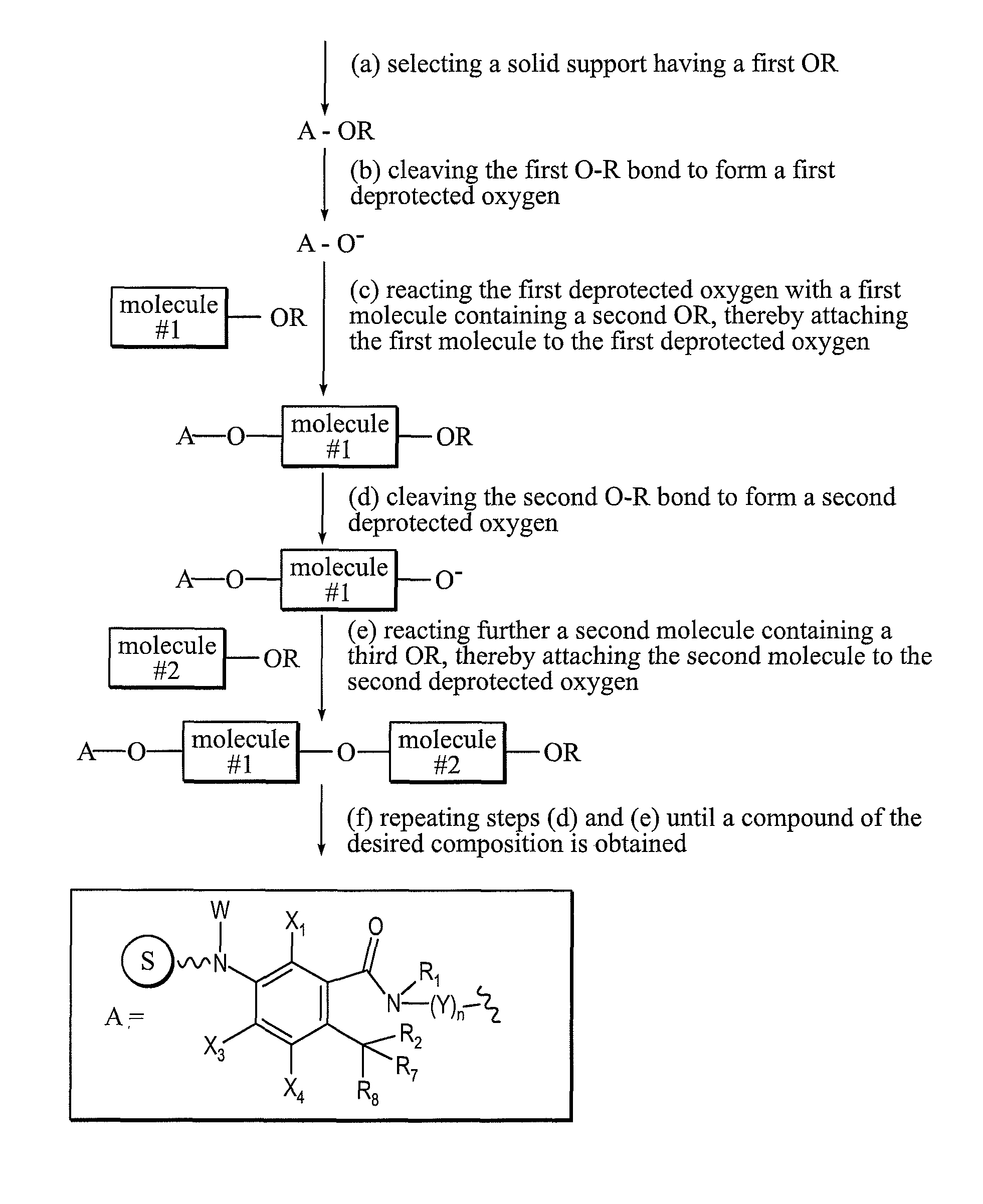Solid support reagents for synthesis
a technology of solid support and reagents, which is applied in the field of compound compounds, can solve the problems of less convenient and tedious methods to prepare oligonucleotides with a modified 3′ terminus than the better known methods to prepare 5′ modified, and the useful synthetic methods for the synthesis of 3′-substituted oligonucleotides are slower to develop and reported to give unpredictable results. , to achieve the effect of reducing the extent and reducing the compression strength
- Summary
- Abstract
- Description
- Claims
- Application Information
AI Technical Summary
Benefits of technology
Problems solved by technology
Method used
Image
Examples
example 1
[0124]Scheme 1 below shows the preparation of compounds of the Formula IV, where R1 and R2 form a single bond and together R7 and R8 form a carbonyl. The synthesis begins with the reaction of benzofuran 1 with the primary amine 3, where Y can be selected from a methylene or substituted methylene, nucleoside, nucleotide, protected nucleoside, protected nucleotide, C5-C8 aryl, arylalkyl, heteroalkyl, heterocycle, and heteroaryl, and n can be 1-10. The aromatic ring of the benzofuran moiety can be optionally substituted, for example with halogen atoms such as F or Cl. The hydroxyl group can be protected to form compound 2, where R can be selected from hydrogen, SiRaRbRc, CRaRbRc, heteroalkyl, and C1-C6 alkyl, and Ra, Rb, and Rc can be the same as or different from each other and each can represent methyl, ethyl, i-propyl, t-butyl, phenyl or substituted phenyl. The aromatic nitro group of 2 can be reduced for example, using hydrogen to form a primary amine which can then be coupled to a...
example 2
[0126]Scheme 2 below shows the preparation of compounds of the Formula IV, where one of R2, R7, and R8 is oxyacyl and the remaining R2, R7, and R8 are hydrogen. The synthesis begins with the reaction of benzofuranone 4 with amine 3 to form an amide, where Y can be selected from a methylene or substituted methylene, nucleoside, nucleotide, protected nucleoside, protected nucleotide, C5-C8 aryl, arylalkyl, heteroalkyl, heterocycle, and heteroaryl, and n can be 1-10. The hydroxyl group attached to Y can be protected to form compound 5, where Z is OR and R can selected from hydrogen, SiRaRbRc, CRaRbRc, heteroalkyl, and C1-C6 alkyl, and Ra, Rb, and Rc can be the same as or different from each other and each can represent methyl, ethyl, i-propyl, t-butyl, phenyl or substituted phenyl. The remaining hydroxyl group in 5 can be protected as an acetate using acetic anhydride, pyridine, and DMAP catalyst to form compound 6. The aromatic nitro group of 6 can be reduced to form an amine for exam...
example 3
[0128]Scheme 3 below shows the preparation of compounds of the Formula V, where for example, R3 and R4 are both F, t=1-3 and s=0 or R5 and R6 are both F, s=1-3 and t=0. The synthesis begins with the coupling of dihydrofurandione 8 with amine 3 to form the amide 9. The primary hydroxyl group of 9 can be protected using a chloride reagent R—Cl and pyridine to form 10, where Y can be selected from a methylene or substituted methylene, nucleoside, nucleotide, protected nucleoside, protected nucleotide, C5-C8 aryl, arylalkyl, heteroalkyl, heterocycle, and heteroaryl, and n can be 1-10. R can be selected from hydrogen, SiRaRbRc, CRaRbRc, heteroalkyl, and C1-C6 alkyl, and Ra, Rb, and Rc can be the same as or different from each other and each can represent methyl, ethyl, i-propyl, t-butyl, phenyl or substituted phenyl. The carboxylic acid of 10 can then be coupled to a commercially available solid support derivatized with an amide moiety to form the solid support reagent 11.
[0129]
PUM
| Property | Measurement | Unit |
|---|---|---|
| particles size | aaaaa | aaaaa |
| temperature | aaaaa | aaaaa |
| molecular weight | aaaaa | aaaaa |
Abstract
Description
Claims
Application Information
 Login to View More
Login to View More - R&D
- Intellectual Property
- Life Sciences
- Materials
- Tech Scout
- Unparalleled Data Quality
- Higher Quality Content
- 60% Fewer Hallucinations
Browse by: Latest US Patents, China's latest patents, Technical Efficacy Thesaurus, Application Domain, Technology Topic, Popular Technical Reports.
© 2025 PatSnap. All rights reserved.Legal|Privacy policy|Modern Slavery Act Transparency Statement|Sitemap|About US| Contact US: help@patsnap.com



